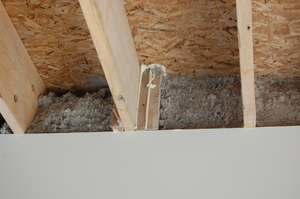Building energy-efficient homes is bright star in new house construction

This home in the Stoneyfield Meadows subdivision outside of downtown Dexter. is the first Energy Star house completed by Marhofer/Campbell Building Companies.. Builder Jack Campbell wants all of his future houses to be Energy Star rated.
Janet MIller | For AnnArbor.com
Still, long-time homebuilder Jack Campbell sees a future in new home construction: Building energy-efficient houses. And he’s joining the revolution.
“You can’t pick up a trade publication and not read about not only building green houses but building green subdivisions,” Campbell said.
His company, Marhofer/Campbell Building Companies, completed its first Energy Star rated project with Suzanne and Dale Bixby’s 2,500-square-foot, four-bedroom, 3 1/2-bath house in the Stoneyfield Meadows subdivision, three minutes northwest of downtown Dexter.
The Bixbys were looking for a new house with a rural setting (a flock of sheep graze across the street) but close to Ann Arbor for work. They wanted it to be big enough to accommodate their young family and also to host overnight visitors.
Campbell wanted it to win an Energy Star rating.
In order to obtain a rating, a house built in the lower half of Michigan must score 85 points or less on the HERS (Home Energy Rating Score) scale, which ranges from 150 (think 1960s era homes built when energy was cheap) to zero, where homes produce all their energy needs with solar panels and other green features. Under the HERS rating, the lower the score, the more energy efficient.
When Campbell began learning what it would take to make one of his houses Energy Star rated, he found out he was already doing many of the right things: Installing Energy Star windows and appliances, using 30-year roof shingles and high-efficiency furnaces.
But to improve energy efficiency, Campbell hired a third-party energy rater. “We wanted to take the next step,” he said.
Cellulose insulation was added to the basement walls of the Bixby’s house and foam insulation was used to block air from coming in around wires and the electrical box.
“We tightened up the envelope,” Campbell said. Increased costs were relatively minor and not passed on to the buyer, Campbell said.
When the HERS testing was done, the house scored a 74, enough for an Energy Star rating, but not enough for a higher level Energy Star Plus rating.
“Your goal is always to do better, but this is a start,’ Campbell said.

Cellulose insulation was added to the basement walls of the house and foam insulation was used to block air from coming in around wires and the electrical box to help win it an Energy Star rating.
Janet Miller | AnnArbor.com
Two-by-fours could be replaced by two-by-sixes in the walls to allow for more insulation and insulation could be added to the top two feet of the basement wall, Campbell said. Both measures would add cost but improve the HERS score. A geothermal heating and cooling system would win big energy savings points but add about $15,000 to the house price, Campbell said.
Building greener didn’t change the aesthetics of the house, said Kim Neuens, project manger of the subdivision.
The popular items are still there in the Bixby’s house: Merillat cabinets, ceramic tile foyer, natural oak floors, granite kitchen countertops, a wood burning fireplace, the reverse drop ceiling in the living room and the vaulted ceiling in the master suite.
Ground for the subdivision was broken six or seven years ago: Some 50 acres of former farmland was developed with room for 33 houses. Eight lots remain vacant.
While the market has slowed, there’s been work, Campbell said. The company started three homes in the subdivision in 2010 and Realtors have been asking for available houses, Campbell said. That has made him consider building a spec house.
“Spec building was the biggest part of our business,” Campbell said.
He wants all of his future houses to be Energy Star rated.


Comments
townie
Thu, Nov 18, 2010 : 10:32 a.m.
I don't care how energy efficient you build it, when you start from the premise of building a large, brand new house, well outside of town, you will never be able recoup the energy wasted on first building it, and then jumping in your car 5 times a day to do anything. I wonder if those sheep are grazing on land that had the development rights purchased under our Greenbelt program. If so, I'm glad we could provide the rural character for these folks at taxpayer expense. If not, I bet they'll be the first to complain about the new subdivision going in when it replaces that pasture some day. Gimme a break. There are plenty of vacant foreclosed homes in town or very close that these folks could have purchased if they really cared about saving energy.
Eby
Thu, Nov 18, 2010 : 10:30 a.m.
Also related but isn't showing up in the list is AnnArbor.com's article on the green renovation in the historic district for a non-new build. The Environment Report on Michigan Radio also just did an update on the project.